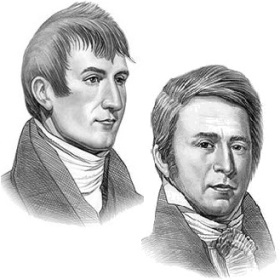|
May 29,1804
Here we halted for the purpose of hunting and drying
our provisions, and making the necessary celestial observations.
This being completed, we set sail on the 29th at four o'clock,
and at four miles distance encamped on the south-side, above
a small creek, called Deer creek.
May 30,1804
The next day, 30th,
we set out early, and at two miles distant reached a large cave,
on the north, called Montbrun's tavern, after a French trader
of that name, just above a creek called after the same person.
Beyond this is a large island, and at the distance of four miles,
Rush creek coming in from the south, at eleven, Big-muddy river
on the north, about fifty yards wide; three miles further, is
Little-muddy river on the same side, opposite to which we encamped
at the mouth of Grindstone creek. The rain which began last
night continued through the day, accompanied with high wind
and some hail. The river has been rising fast for two days,
and the country around appears full of water. Along the sides
of the river to day we observe much timber, the cotton wood,
the sycamore, hickory, white walnut, some grapevines, and rushes—the
high west wind and rain compelled us to remain all the next
day, May 31.
May 31,1804
In the afternoon a
boat came down from the Grand Osage river, bringing a letter
from a person sent to the Osage nation on the Arkansaw river,
which mentioned that the letter announcing the cession of Louisiana
was committed to the flames—that the Indians would not believe
that the Americans were owners of that country, and disregarded
St. Louis and its supplies. The party was occupied in hunting,
in the course of which, they caught in the woods several very
large rats. We set sail early the next morning, June 1st, and
at six miles distant passed Bear creek, a stream of about twenty-five
yards width; but the wind being ahead and the current rapid,
we were unable to make more than thirteen miles to the mouth
of the Osage river; where we encamped and remained the following
day, for the purpose of making celestial observations. The Osage
river empties itself into the Missouri, at one hundred and thirty-three
miles distance from the mouth of the latter river. Its general
course is west and west southwest through a rich and level country.
At the junction the Missouri is about eight hundred and seventy-five
yards wide, and the Osage three hundred and ninety-seven. The
low point of junction is in latitude 38° 31' 16", and at a short
distance from it is a high commanding position, whence we enjoyed
a delightful prospect of the country.
The Osage river gives or owes its name to a nation inhabiting
its banks at a considerable distance from this place. Their
present name however, seems to have originated from the French
traders, for both among themselves and their neighbors they
are called the Wasbashas. They number between twelve and thirteen
hundred warriors, and consist of three tribes: the Great Osages
of about five hundred warriors, living in a village on the south
bank of the river—the Little Osages, of nearly half that number,
residing at the distance of six miles from them—and the Arkansaw
band, a colony of Osages, of six hundred warriors, who left
them some years ago, under the command of a chief called the
Bigfoot, and settled on the Vermillion river, a branch of the
Arkansaw.
In person
the Osages are among the largest and best formed Indians, and
are said to possess fine military capacities; but residing as
they do in villages, and having made considerable advance in
agriculture, they seem less addicted to war, than their northern
neighbors, to whom the use of rifles gives a great superiority.
Among the peculiarities of this people, there is nothing more
remarkable than the tradition relative to their origin. According
to universal belief, the founder of the nation was a snail passing
a quiet existence along the banks of the Osage, till a high
flood swept him down to the Missouri, and left him exposed on
the shore. The heat of the sun at length ripened him into a
man, but with the change of his nature, he had not forgotten
his native seats on the Osage, towards which, he immediately
bent his way. He was however soon overtaken by hunger, and fatigue,
when happily the Great Spirit appeared, and giving him a bow
and arrow, showed him how to kill and cook deer, and cover himself
with the skin. He then proceeded to his original residence,
but as he approached the river, he was met by a beaver, who
inquired haughtily who he was, and by what authority he came
to disturb his possession. The Osage answered that the river
was his own, for he had once lived on its borders. As they stood
disputing, the daughter of the beaver came, and having by her
entreaties reconciled her father to this young stranger, it
was proposed that the Osage should marry the young beaver, and
share with her family the enjoyment of the river. The Osage
readily consented, and from this happy union there soon came
the village and the nation of the Wasbasha, or Osages, who have
ever since preserved a pious reverence for their ancestors,
abstaining from the chace of the beaver, because in killing
that animal, they killed a brother of the Osage. Of late years,
however, since the trade with the whites has rendered beaver
skins more valuable, the sanctity of these maternal relatives
has visibly reduced, and the poor animals have nearly lost all
the privileges of kindred.
Next Journal
Entry
|

